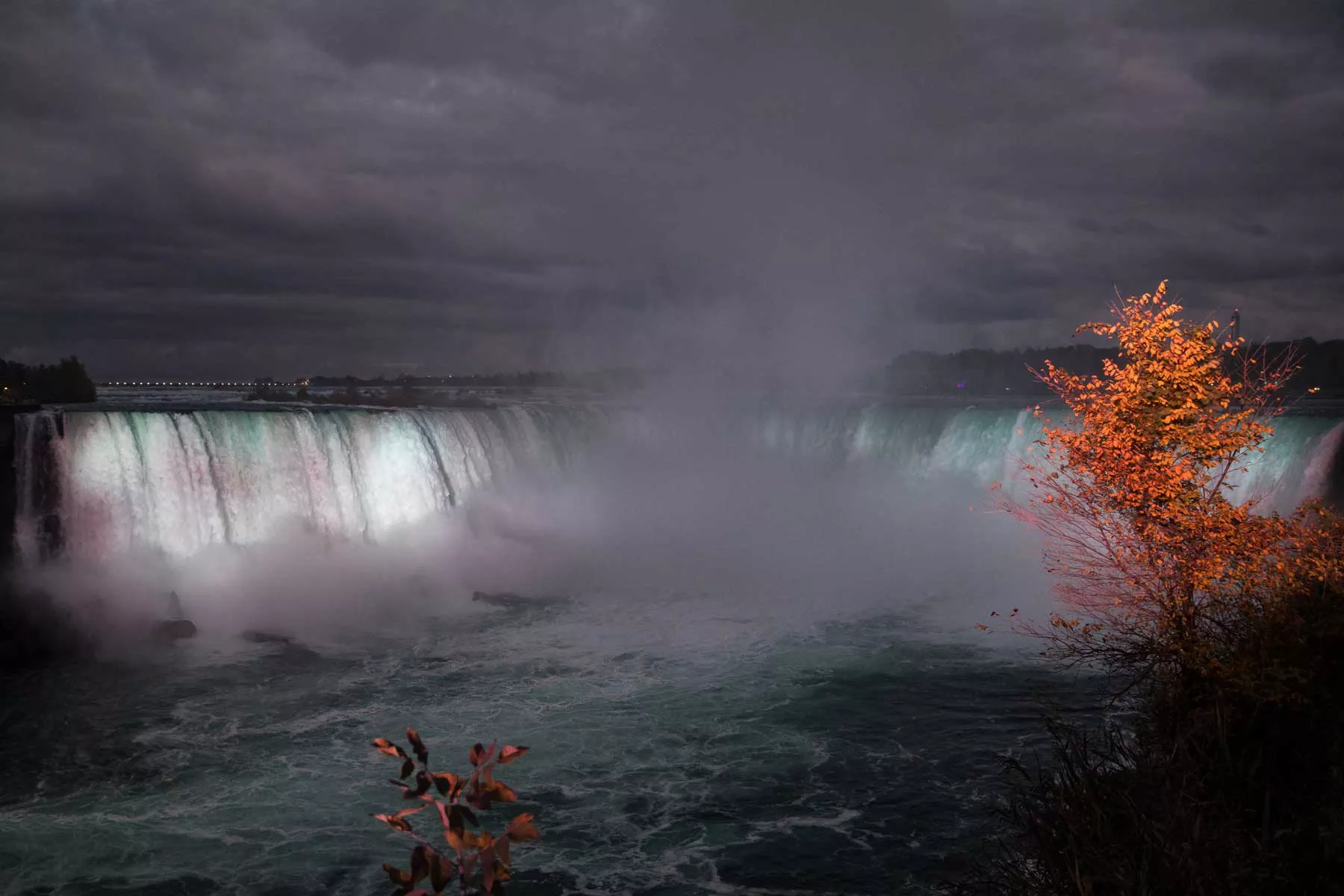Day One
Viji and I started at—where else?—the falls. Over lunch at Table Rock House Restaurant (entrées $24–$38), which is perched at the edge of Horseshoe Falls, we oohed and aahed at the crashing curtain of water right in front of us. Next, we took a short stroll to the Niagara Parks Power Station, which used the falls to provide electricity to much of the region for a century, beginning in 1905. It reopened in 2021 as an interactive museum that highlights the lives of the people who worked at the plant.
As we stood in the shadows of the turbines we’d learned about earlier, projections brought the workers and machinery to life.
We also took a hard-hat sneak peek at an upcoming attraction, which has since then opened. As of July 2021, a glass elevator takes people 180 feet underground into the old Tailrace Tunnel. The descent mimics the route the water once took through the power plant. After disembarking at the bottom, guests are able to stand on an outdoor platform for an entirely new vantage point of the falls.
That evening, we had dinner at AG Inspired Cuisine (prix fixe $89), a restaurant set in a former creamery in downtown Niagara Falls. The menu— which included a winter-squash bisque, juniper-roasted deer loin with a vegetable cassoulet, and a cranberry poached pear—celebrates Niagara terroir, and much of the produce comes from the restaurant’s own farm 10 minutes away.
Later in the night, we returned to the power station to experience Currents: Niagara’s Power Transformed, an immersive indoor light and sound show. As we stood in the shadows of the turbines we’d learned about earlier, projections brought the workers and machinery to life and helped convey the importance of the plant to the region and the province. Afterward, we retired to the historic Old Stone Inn Boutique Hotel (doubles from $159), located steps from the water.
Day Two
On our second morning we met Harper, our guide for a tour that followed the journey of the enslaved Africans (including Harper’s own ancestors) who made their way to Canada. Most history books stop with their arrival via the Underground Railroad, but Harper shared what happened in the decades that followed. She told us about Josiah Henson—a once-enslaved man who found his way to freedom along with his wife and four children, inspired Harriet Beecher Stowe’s novel Uncle Tom’s Cabin, and became a founder of one of the most successful Black communities in southern Ontario. Harper also talked about the predecessor of the NAACP, a civil rights organization called the Niagara Movement, which had its initial meeting in 1905 in Fort Erie, a town on the Niagara River. As I looked out at the powerful waters, I found it hard not to become emotional at the thought of the men, women, and children who risked their lives to cross over to freedom.
Viji and I continued our drive along the river to meet Tim Johnson at the Landscape of Nations. He is the director of the Landscape of Nations 360° Indigenous Education Initiative, a nonprofit that aims to educate Canadians about the contributions of Indigenous peoples. Johnson walked us across the site of the War of 1812’s pivotal Battle of Queenston Heights. We paused just outside a collection of rails meant to symbolize a longhouse, an Indigenous style of dwelling, before following a stone trail through a memorial built to acknowledge the Six Nations’ aid in the war.
Visitors can enter without a guide, but being with Johnson allowed Viji and me to ask questions and reframe the history we’d been taught as kids.
Day Three
This is wine country—there are more than 50 vineyards in the Niagara region along Lake Ontario—and Niagara-on-the-Lake is particularly renowned for its ice wines. We began our tasting tour just outside of town with lunch at the intimate Two Sisters Vineyards (entrées $17–$40). As it turns out, sipping Cabernet Francs and Rieslings while nibbling a delicate beef carpaccio and crisp pizza is a good way to spend an afternoon.
What seemed like just a couple of hours later, we were back at the table, this time indulging in a dinner of roasted Ontario duck breast at Trius Winery & Restaurant (prix fixe from $66). Winemaker Craig McDonald paired his award-winning vintages with chef Frank Dodd’s creations, which included butternut-squash soup and a spiced-pumpkin blondie dessert.
After dinner, we experienced one of Niagara-on-the-Lake’s most beloved attractions: the Shaw Festival, which began in the early 1960s as an annual event that celebrated the works of George Bernard Shaw, but now includes a variety of productions in three theaters.
Day Four
On our final day, Harper’s words not to forget the falls were on my mind, so we headed back to where our journey began. We were ready for some downtime, so we booked sessions in the Hydrotherapy Infinity tub at Christienne Fallsview Spa.
As I sank into the steaming waters and stared at the falls and the gardens that surround them, I thought of the little girl who’d once underappreciated this gem. No longer. This, I thought as the bubbles worked their magic, was the postcard memory I came for.
Niagara Falls’ Iconic Maid of the Mist Experience Just Got Better
A version of this story first appeared in the February 2022 issue of GoTravelDaily under the headline Surprise and Delight.





